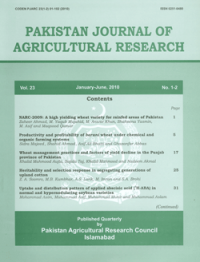Zafar Khokhar*, Imtiaz Hussain**, Badruddin Khokhar* and Muhammad Sohail**
ABSTRACT
Due to reduction in tillering period and increased risk of hot weather during grain filling, late planting results in linear reduction in wheat grain yield. A study was undertaken to determine the effects of planting dates on growth and yield of different wheat genotypes in Sindh. The trial was laid out in RCBD with split plot arrangement having four replications during 2000-01 and 2001-02 at Sakrand, Sindh. Four sowing dates i.e. November 1 and 15, December 1 and 15 were in main plots, whereas six wheat genotypes (V-7001, V-7002, V-7004, MPT-6, Abadgar-93, and Anmol-91) were in sub plots. Because of better tillering, plant growth, growth period, number of grain per unit area and grain weight, November 15 planted wheat had maximum grain yield of 5904 kg ha-1, followed by November 1 and December 1 which gave 5302 and 4948 kg ha-1 respectively. Wheat planted on December 15 resulted in minimum grain yield of 4756 kg ha-1. Wheat genotype, V-7002 had significantly (P<0.05) higher grain yield of 5578 kg ha-1 in comparison with other genotypes. Whereas genotype MPT-6 had grain yield of 5366 kg ha-1 that was also significantly higher than other genotypes. However, V- 7004 had minimum grain yield of 4716 kg ha-1 in comparison with other genotypes. While evaluating performance of different genotypes on different sowing dates, V-7002 resulted in maximum yield on November 15 and late planting. On the other hand, V-7004 had lower yield on all planting dates. Results from the study revealed that maximum grain yield could be achieved with wheat planted in first fortnight of November and any delay in wheat planting might reduce wheat yield.
To share on other social networks, click on any share button. What are these?






